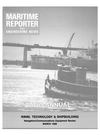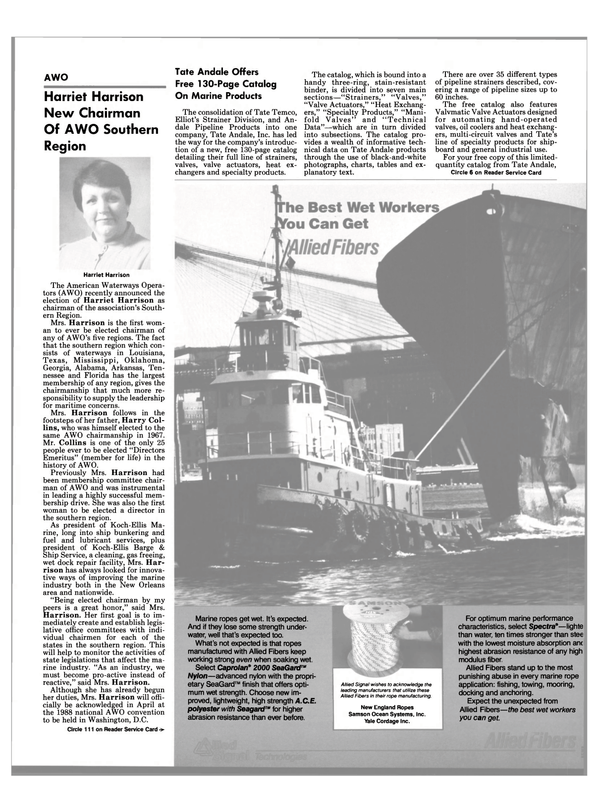
Alfa-Laval Offers Quality Plate Heat Exchangers For Navy Shipboard Cooling Duties
—Free Color Brochures Available— Alfa-Laval, Inc., Ft. Lee, N.J., is offering three color brochures and one technical paper detailing the relative economic and performance advantages of their marine plate heat exchangers.
These reports explain that Plate Heat Exchangers (PHE) and Shell and Tube Heat Exchangers (S&T) have been used for many Navy and commercial marine shipboard cooling duties. However, certain features of the PHE can make it a more viable alternative than S&T coolers.
Alfa-Laval offers a full line of PHEs which have been in service worldwide with most shipping concerns for over 25 years. Since their introduction, more than 7,500 units have been put into marine service.
The company's PHE consists of a plate pack and a frame. The frame consists of a fixed plate to which all pipes are connected. An upper and lower carrying bar are supported by an outrigger or support column. The plate pack is suspended from the upper carrying bar and is clamped together by compression bolts.
The plate packs are pressed from titanium for seawater service and stainless steel for freshwater service.
The unit is normally installed by deck mounting but can be mounted in other configurations as well.
PHEs that are supplied to the U.S. Navy have met extensive requirements for shock and vibration.
According to Alfa-Laval, the alternating titanium plate and gasket design used in the configuration of PHEs prevents interleakage of the two fluids and allows the use of considerably higher liquid velocities without erosion. The corrugated Chevron design of the plates also gives the unit a considerably higher heat transfer coefficient and, therefore, requires less cooling water flows.
The company reports that PHEs have proven to be easily maintainable both in port and at sea. No special tools are required to disassemble, inspect and clean the unit.
The PHE offers excellent performance in close temperature approaches or hard-to-perform thermal duties such as cooling a liquid down to 100 degrees F when using 95 degree seawater. On many of the test and evaluations ships, the reports indicated that for the first time in years, the cooling system was able to meet the performance requirements and be available for service 100 percent of the time.
Light in weight and innovative in performance, the PHE lends itself to retrofitting, as the unit can be disassembled dockside into its component parts, hand-carried to the location of installation and reinstalled by the ship's force, eliminating the need for cranes, or removal of other equipment so that the exchanger can be put into place.
One of the most impressive features of the PHE is its ability to be modified in the field to compensate for changes in the thermal duty. A PHE can be expanded merely by adding plates, changing the plates, or, in the other extreme, by taking plates out.
For U.S. Navy combatant vessels, the Alfa-Laval plate heat exchanger has met and passed the requirements of both MIL-STD-167-1 vibration and MIL-STD-901C shock for Grade A, Class 1, hull-mounted machinery.
Applications from 0-1,000 gpm include seawater to fresh water, seawater to oil, and fresh water to fresh water.
Alfa-Laval is offering free color brochures on their line of marine plate heat exchangers. Through the use of color photographs, drawings, tables and explanatory text, the brochures fully detail the features and advantages of Alfa-Laval PHEs. For your free copies, Circle 36 on Reader Service Card
Read Alfa-Laval Offers Quality Plate Heat Exchangers For Navy Shipboard Cooling Duties in Pdf, Flash or Html5 edition of March 1988 Maritime Reporter
Other stories from March 1988 issue
Content
- FIRST A.W.O. ANNUAL ISSUE page: 4
- Crane Consolidates Two Business Units To Form Crane M i d w e st page: 6
- Unitor Ships Service Acquires G a m l e n M a r i ne page: 6
- Fort Schuyler Forum To Be Held March 16 page: 7
- Racal Wins Major Radar Order From Midland Enterprises page: 7
- Racal To Demonstrate New Color ARPA At Whitehall Club In New York City page: 8
- New Diesel Pump Company Formed page: 8
- Substantial Savings Realized With HydroSwage MK III Tube Expander page: 9
- Slingmax Rigging Products Offers Literature On New Load-Lifting Equipment page: 9
- Quality Shipyards Delivers Third Pushboat In Series of Three To Ashland Oil Company page: 10
- Centrico Offers Advanced Oil Purifying Equipment page: 10
- Alfa-Laval Offers Quality Plate Heat Exchangers For Navy Shipboard Cooling Duties page: 11
- Constant-Tension Winch For Handling Rescue Boats Offered By Braden page: 12
- New Wooster Catalog Lists Anti-Slip Safety Stair/Walkway Products page: 12
- Tate Andale Offers Free 130-Page Catalog On Marine Products page: 13
- Harriet Harrison New Chairman Of AWO Southern Region page: 13
- AWO ANNUAL page: 14
- AWO'S REGULATORY ADVOCACY page: 18
- 1987: A YEAR OF MAJOR THREATS AND IMPORTANT VICTORIES page: 23
- Why You Should Be A Member Of AWO page: 24
- NAVY WILL SPEND OVER $9 BILLION IN FY 1988 ON R&D page: 27
- Fairbanks Morse Brochure Outlines Benefits Of New Ignition Generator page: 31
- MAJOR NAVY CONTRACTS page: 33
- A&T Receives Navy Contracts Worth $14.2 Million page: 37
- Textron Marine Systems Delivers 12th LCAC To Navy page: 38
- Avondale Industries Christens Their Second Landing Ship Dock In Series Of Five page: 38
- Mid-Coast Marine To Perform Overhaul Work At Coos Bay Drydock page: 39
- Moss Point Marine Delivers First Of Four Army Landing Ships page: 40
- Bethlehem Steel Christens Navy Oceanographic Survey Ship At Sparrows Point Shipyard page: 40
- Newport News Christens Newest Nimitz Carrier page: 41
- Avondale Plans Purchase Of Lockheed Shipbuilding's Gulfport Marine Division page: 42
- Free Color Brochure On Safety Release Hook For Rescue Boats page: 42
- First U.S.-Built Surimi Catcher/Processor Delivered By Halter Marine page: 46
- Lexair Offers Catalogs On 'Hi-Cyclic' And Poppet Type Two-Way Valves page: 47
- Navigation & Communications Equipment Review page: 48
- Robertson-Shipmate Introduces Multi-Station VHF Radiotelephone To U.S. Marine Market page: 56
- New Public Dock Facility At Port Of Iberia Is Reported A Success page: 56
- Skaarup Shipping Corporation Announces Executive Changes page: 62
- Cunard Installs Computerized Maintenance System From MMS Aboard Queen Elizabeth 2 page: 62
- National Waterways Conference Cosponsoring Seminar On Transportation Futures Markets page: 65
- Caterpillar Announces Extended Service Coverage For Industrial & Marine Engines page: 68
- Hyundai Building First In Series Of Three 250,000-Dwt VLCCs For World Wide Shipping Agency page: 68


